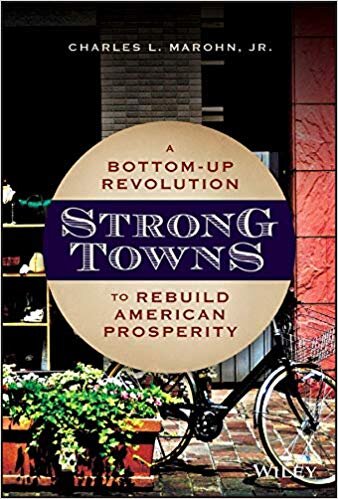 |
| Your humble blogger and his humble sister in the days of their suburban childhood |
Response to chapters 1 & 2 is
here. Response to chapters 3 & 4 is
here. Response to chapters 5-7 is
here. Response to chapters 8 & 9 is
here.
In its final chapter,
Strong Towns: A Bottom-Up Revolution to Rebuild American Prosperity (Wiley, 2020) suddenly gets soul. Author and Strong Towns founder Charles Marohn, having made his case that the bankruptcy of local governments across is a broad but under-recognized problem, turns to the intangible advantages of more traditional approaches to development. Besides restoring your town's economy and government to a sound financial footing, you get neighborhoods with genuine community; opportunities for children to go places on their own; the physical fitness benefits that come from regular walking; something more real and important than our
toxic political divide; and the sort of deep meaning to life that comes from living intentionally. He concludes, "
Working together in an intentional way, it is possible to make our places stronger financially
while also improving the lives of people" (p. 218, italics mine).
Marohn begins chapter 10 with a striking anecdote of their Life Before, in which his daughter meets her bff on the first day of kindergarten, and it turns out she lives right across the street:
My wife and I had lived in our house for over a dozen years at that point. Holly's family had lived in theirs even longer. We were both active families, involved in the community, with work, and with our churches. Yet, the thick woods covering the lots we each occupied along a cul-de-sac was enough of a barrier to our getting to know each other that we didn't even realize our neighbors across the street had a little girl the same as ours. (p. 200)
Not long after, his family moved to "a 1914 home in a historic area" of Brainard, Minnesota (p. 202), and a lot of the chapter discusses his epiphanies about life in a traditionally-developed urban area. Meanwhile, I'm thinking, Chuck Marohn was living on a
cul-de-sac? Who would have thunk it?
Because we all come from somewhere. I come from the western suburbs of Chicago, with most of my childhood spent in a house built in the 1960s. It was in an older neighborhood, though, and the town had been around long before the Chicago metropolitan area grew to absorb it. I walked to school most of the time, my family could walk to a corner grocery store, and my parents had no concerns about sending me on errands or letting me loose to explore the area by bicycle or on foot.
I have also always had, for some reasons or other, an ambivalent attitude towards cars.
So maybe urbanism was my destiny. But I've also been fortunate for the last 38 years to live within two miles of my workplace. Had I stayed in DuPage County, I probably would have gotten used to the daily commute from cul-de-sac to office park. Maybe in the 1990s I would have read Daniel Kemmis's
Community and the Politics of Place (Oklahoma, 1992) and James Howard Kunstler's
The Geography of Nowhere: The Rise and Decline of America's Man-Made Landscape (Simon & Schuster, 1993), and something in me might have been stirred, but I wouldn't have known what to do about it, because what alternative would I have had?
Who would I be if I'd never read Jane Jacobs? Who would I be if I hadn't started following Chuck Marohn?
I am fortunate to live in a place with emerging walkability, in the company of
fellow urbanists and
cyclists and
community organizers who keep pushing the envelope in hopes of sustainable lifestyles, and where the city government, though the Council keeps hankering after subdivisions and game-changing attractions, is visionary enough to build
protected bike lanes and
sidewalks and do
one-way-to-two-way conversions. I am fortunate to live at a time when a variety of writers and designers have given me a vocabulary to articulate my inchoate discontent with 20th century America: people like the
new urbanists,
Ray Oldenburg,
Ellen Shephard, and the inspiration for the Corridor Urbanism group,
Dave Alden. I see the world more clearly, and live in it more consciously, thanks to these encounters. And Strong Towns has been essential to all this.
And now those essentials are in this 200-odd-page book:






























